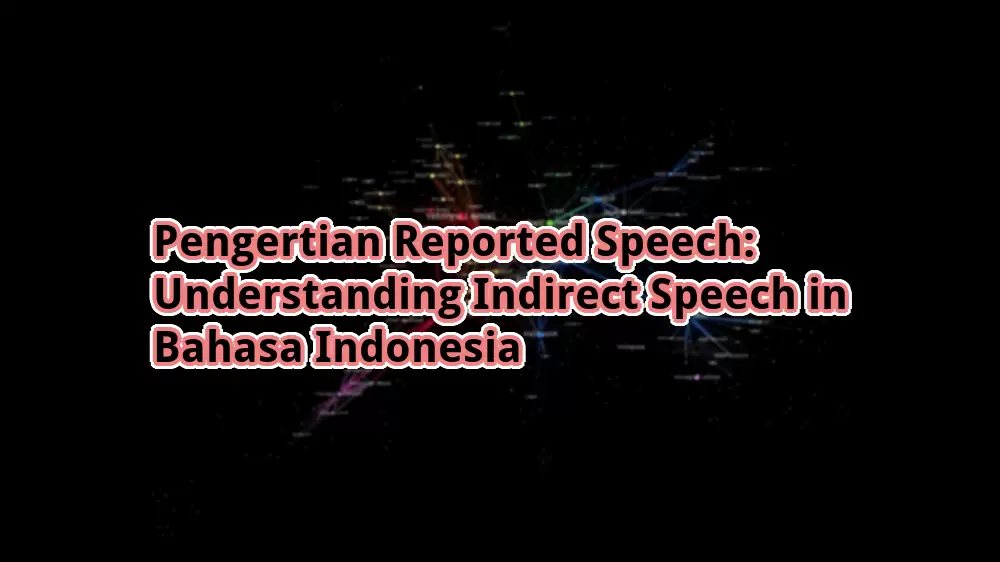
Pengertian Reported Speech
Introduction
Hello zflas.co! Welcome to this informative article about pengertian reported speech. In this article, we will explore the concept of reported speech in the Indonesian language. Reported speech, also known as indirect speech, is an essential aspect of communication that allows us to convey what someone else has said without quoting them directly. Understanding how to use reported speech correctly is crucial for effective communication and expressing the thoughts and ideas of others accurately. Let’s dive into the world of reported speech and explore its strengths, weaknesses, and everything you need to know.
What is Reported Speech?
Reported speech refers to the act of relaying or reporting someone else’s words or thoughts without using their exact words. When we use reported speech, we express what someone else has said or thought in our own words. This form of speech is commonly used in conversations, interviews, storytelling, and written texts. By using reported speech, we can summarize, paraphrase, or report what others have said, allowing us to convey information while maintaining our own voice and style.
? Main Points:
- Reported speech is the act of relaying someone else’s words or thoughts.
- It allows us to express what someone else has said in our own words.
- Reported speech is commonly used in conversations, interviews, and written texts.
Strengths of Reported Speech
Reported speech offers several strengths that contribute to effective communication. Understanding and utilizing these strengths can greatly enhance your proficiency in conveying the thoughts and ideas of others. Let’s explore the strengths of reported speech:
1. Clarity and Accuracy
Reported speech enables us to accurately convey the meaning and essence of what someone else has said. By paraphrasing or summarizing their words, we can eliminate any confusion or misinterpretation that may arise from direct quotations. This clarity ensures that our message aligns with the original speaker’s intentions.
2. Integration and Flow
When incorporating reported speech into our conversations or written texts, it seamlessly integrates with our own words and thoughts. This integration allows for a smooth flow of ideas, making the communication more coherent and engaging for the audience.
3. Flexibility and Adaptability
Reported speech offers flexibility in adjusting the tense, pronouns, and other elements to fit the context and speaker’s intentions. This adaptability allows us to convey the reported speech accurately while maintaining grammatical correctness and coherence.
4. Conciseness
By using reported speech, we can summarize lengthy or complex statements into concise and comprehensible forms. This conciseness helps in conveying the essence of the original speech without overwhelming the audience with unnecessary details.
5. Neutrality
In some situations, using reported speech can help maintain neutrality and objectivity. By relaying someone else’s words, we avoid injecting personal biases or opinions into the message, ensuring fairness and accuracy.
6. Variety and Style
Reported speech allows us to infuse our own style and tone while conveying the thoughts and ideas of others. This variety in presentation enhances the overall impact and engagement of the communication, making it more interesting and captivating for the audience.
7. Preservation of Context
When using reported speech, we can include contextual information alongside the reported words, providing a deeper understanding of the message. Contextual details such as time, place, or circumstances help the audience grasp the full meaning and significance of the reported speech.
Weaknesses of Reported Speech
While reported speech offers various strengths, it also has its limitations and weaknesses. Understanding these weaknesses is essential for using reported speech effectively and avoiding potential pitfalls. Let’s explore the weaknesses of reported speech:
1. Potential Distortion
When paraphrasing or summarizing someone else’s words, there is a risk of unintentionally distorting the original meaning. Misinterpretation or omission of crucial details can alter the intended message, leading to misunderstandings or miscommunication.
2. Loss of Directness
Reported speech, by its nature, eliminates the directness and immediacy of the original words. This indirectness may result in a diluted impact, especially when conveying emotions, urgency, or personal experiences.
3. Limited Attribution
Using reported speech may not always provide a clear attribution of the speaker. In certain situations, it is vital to identify the source of the information to establish credibility or accountability. Reported speech can sometimes hinder this attribution process.
4. Potential Bias
Even though reported speech aims to maintain neutrality, our interpretation and presentation of someone else’s words may inadvertently introduce bias or subjective elements. It is crucial to be mindful of our own perspectives and biases when using reported speech.
5. Inability to Convey Verbatim
Reported speech cannot capture the exact words and nuances of the original speaker. This limitation may be significant in situations where precise wording or specific phrasing is crucial for conveying the intended meaning accurately.
6. Loss of Non-Verbal Cues
When using reported speech, non-verbal cues such as facial expressions, gestures, or tone of voice cannot be conveyed effectively. These cues often play a vital role in understanding the full context and emotional nuances of the original speech.
7. Overreliance on Interpretation
Reported speech heavily relies on our interpretation and understanding of the original speech. If our interpretation deviates significantly from the speaker’s intent, the reported speech may not accurately represent their thoughts or ideas.
Pengertian Reported Speech – Complete Information
| Term | Pengertian |
|---|---|
| Reported Speech | Proses melaporkan kata-kata atau pikiran orang lain tanpa menggunakan kata-kata mereka secara langsung. |
| Direct Speech | Ketika kita mengutip kata-kata orang lain secara langsung. |
| Indirect Speech | Ketika kita melaporkan apa yang dikatakan orang lain dengan menggunakan kata-kata kita sendiri. |
| Quotation Marks | Tanda baca yang digunakan untuk menandai ucapan langsung atau kutipan langsung. |
| Reporting Verb | Kata kerja yang digunakan untuk melaporkan kata-kata orang lain. |
| Backshift of Tenses | Perubahan bentuk waktu dalam kalimat laporan untuk mengindikasikan bahwa pernyataan tersebut dikatakan di masa lalu. |
| Reporting Adverbs | Kata keterangan yang digunakan untuk memberikan informasi tambahan tentang cara, waktu, atau tempat ucapan tersebut dilakukan. |
Frequently Asked Questions (FAQs)
1. Apa itu pengertian reported speech?
Reported speech adalah proses melaporkan kata-kata atau pikiran orang lain tanpa menggunakan kata-kata mereka secara langsung. Hal ini dilakukan dengan menggunakan kata-kata kita sendiri untuk melaporkan apa yang dikatakan oleh orang lain.
2. Apa perbedaan antara reported speech dan direct speech?
Reported speech adalah ketika kita melaporkan kata-kata orang lain dengan menggunakan kata-kata kita sendiri, sedangkan direct speech adalah ketika kita mengutip kata-kata orang lain secara langsung tanpa mengubahnya.
3. Mengapa penggunaan reported speech penting dalam komunikasi?
Penggunaan reported speech penting dalam komunikasi karena memungkinkan kita untuk mengungkapkan apa yang dikatakan oleh orang lain dengan cara yang jelas dan akurat. Dengan menggunakan reported speech, kita dapat menyampaikan informasi yang relevan dengan mempertahankan gaya dan suara kita sendiri.
4. Apa fungsi tanda kutip dalam reported speech?
Tanda kutip digunakan dalam reported speech untuk menandai ucapan langsung atau kutipan langsung dari seseorang. Mereka membantu membedakan antara kata-kata orang lain dan kata-kata kita sendiri dalam laporan.
5. Apa itu reporting verb?
Reporting verb adalah kata kerja yang digunakan untuk melaporkan kata-kata orang lain. Contoh reporting verb adalah “said,” “told,” “asked,” “explained,” dan sebagainya.
6. Mengapa terjadi perubahan bentuk waktu dalam kalimat laporan?
Perubahan bentuk waktu dalam kalimat laporan, yang dikenal sebagai backshift of tenses, digunakan untuk mengindikasikan bahwa pernyataan tersebut dikatakan di masa lalu. Hal ini penting untuk menjaga konsistensi waktu dalam konteks laporan.
7. Apa itu reporting adverbs?
Reporting adverbs adalah kata keterangan yang digunakan untuk memberikan informasi tambahan tentang cara, waktu, atau tempat ucapan tersebut dilakukan. Contoh reporting adverbs adalah “yesterday,” “here,” “now,” “loudly,” dan sejenisnya.
Conclusion
In conclusion, reported speech plays a vital role in effective communication, enabling us to relay the thoughts and ideas of others accurately and with our own personal touch. While it offers strengths such as clarity, integration, flexibility, and conciseness, it also has weaknesses, including potential distortion, loss of directness, and limited attribution. By understanding these strengths and weaknesses, we can navigate the complexities of reported speech and use it skillfully to enhance our communication.
Remember to always consider the context, audience, and purpose when utilizing reported speech. Practice using reported speech in various scenarios to develop your proficiency and ensure accurate representation of others’ words and thoughts. By mastering the art of reported speech, you can become a more effective communicator and convey ideas with precision and eloquence.
Thank you for reading this article, and we hope you found it informative and engaging. Start incorporating reported speech into your conversations and written texts to elevate your communication skills. Feel free to explore our website for more articles and resources on language and communication.
Disclaimer: The information presented in this article is for educational purposes only. The content is based on the author’s understanding and interpretation of the topic. Readers are advised to consult relevant sources and professionals for specific guidance and advice.
